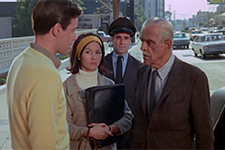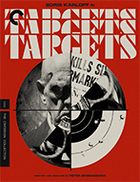Targets
|  Peter Bogdanovich was a film critic and writer for Esquire when low-budget producer Roger Corman asked him to make his first feature film. Bogdanovich had less than a month and $125,000 to make the feature, and he had to incorporate footage from a 1963 Corman-produced horror flick called The Terror and use screen veteran Boris Karloff, who had starred in The Terror and owed Corman two more days of work. On the face of it, that sounds like a recipe for disaster, yet Bogdanovich, against all odds, pulled it off and created Targets, a surprisingly perceptive and engrossing film that deals with two significant shifts in the 1960s, one social and the other cinematic. First, Targets is about the fears of real-life social violence in the U.S., which, in 1968, was at a peak, boiling over with inner-city riots, homicides, political assassinations, and involvement in the Vietnam conflict. The film literally pulses with the tension of impending violence in even the most banal people. In this respect, it ranks alongside such other seminal late-’60s films as Arthur Penn’s Bonnie and Clyde (1967) and Sam Peckinpah’s The Wild Bunch (1969) in capturing the uneasy zeitgeist, although, unlike those films, Targets did not displace its anxiety onto the past. Secondly, and in many ways more interestingly, Targets is about the shift the cinematic horror genre underwent in the 1960s. As Robin Wood argued in his important essay “An Introduction to the American Horror Film,” the horror genre after 1960 (the year Alfred Hitchcock’s Psycho was released) began a crucial shift away from locating horror in inhuman monsters residing in distant, exotic lands (Dracula in Transylvania, for example) and toward a recognition of horror as “both American and familial.” That is, the horror genre forever changed in the 1960s because horror became part of our national landscape and also took on a more nihilistic tone of inevitability—the things that terrify us can never, ever be defeated. Most people don’t think of Targets as a horror film, even though it is deeply frightening and also deals explicitly with the topic in a meta-cinematic sense. Boris Karloff (best known for defining the role of Frankenstein’s monster in the 1930s Universal series) stars as Byron Orlock (the name is an homage to Count Orlock, the Dracula character in F.W. Murnau’s 1922 silent film Nosferatu), an aging horror movie veteran who decides to retire. He has just completed another creaky, Victorian horror movie called The Terror (which is depicted in Targets with footage from the real movie produced by Roger Corman and starring Karloff and a young Jack Nicholson) and has come to the decision that his time is up. His producers don’t take kindly to this, nor does the young director, Sammy Michaels (Peter Bogdanovich), who wants to direct Orlock in his next film, which he promises is a change of pace. Orlock is resilient, though, arguing that he is identified too much with a kind of horror that no longer scares people—the kind that takes place in old, gothic castles in remote lands. To make his point, he hands Sammy a copy of a newspaper with a headline blaring about a depressed honor-roll student who shot six people in a grocery store. Interspersed with Orlock’s narrative is a story about just that kind of horror. We follow two days in the life of Bobby Thompson (Tim O’Kelly), a handsome, seemingly normal young man. He and his wife (Tanya Morgan) live at home with Bobby’s parents (James Brown and Mary Jackson), and they seem to comprise a perfectly harmonious family unit (albeit one that is heavily steeped in gun culture). Yet, we know from the start that something isn’t right with Bobby, the instant he opens the trunk of his Ford Mustang and we see that it is loaded with neatly organized rifles and handguns. He tries to talk to his wife at one point, telling her that sometimes he gets “funny ideas,” but otherwise we know little about Bobby’s interiority. We can only watch as he slowly loses his ability to control his dark impulses and then follows through on what is clearly inevitable from the start: a killing spree. Although it has the slightly shoddy look of a first effort made on a shoestring budget, Targets is frightening in a way few horror movies are because it taps so directly into real fears—things that could conceivably happen, yet have the grandiosity of something that could be made up. Bobby was explicitly based on Charles Whitman, the young man who climbed up to the top of a bell tower on the University of Texas campus in 1966 and began randomly shooting students with a high-powered Remington rifle. Thus, Bobby’s own killing sprees, one of which takes place on the side of a highway and the other at a drive-in movie theater, resonated clearly with audiences at the time of the film’s release (unfortunately, a little too much—it was released soon after the assassination of Robert Kennedy, and audiences largely stayed away). And, unfortunately, it still hits home today in an era where disgruntled employees shooting up their workplaces and angry teenagers committing mass murder in their high schools is a frightening regularity. Targets remains prescient in a way so many paranoid ’60s and ’70s movies don’t, and that’s what is most frightening of all.
Copyright © 2023 James Kendrick Thoughts? E-mail James Kendrick All images copyright © The Criterion Collection | |||||||||||||||||||||||||||||
Overall Rating: 


 (3.5)
(3.5)


